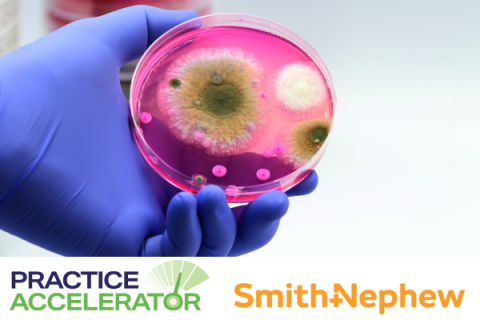Unveiling Fungal Biofilms in Chronic Wounds: More than Just Bacteria
December 20, 2023
Edited by WoundSource Editorial Team
As a physical barrier, the skin is teeming with various microorganisms that form the microbiome, such as fungi, bacteria, and viruses. The clinical understanding of the chronic wound microbiome continues to advance. Conventionally, bacteria are the first type of organism that comes to mind when considering wound contamination. However, a recently published topic review in Current Clinical Microbiology Reports suggests that fungi warrant examination in such cases.1
Wound Biofilms and Bacteria: Too Narrow a Point of View?
In this review, Short and team characterize biofilms as communities of cells that feature increased virulence and antimicrobial resistance that can complicate wound healing.1 Early studies focusing on biofilms zeroed in on bacteria, particularly Pseudomonas aeruginosa, but failed to consider other potential players, like fungi. 2,3 Clinicians may underestimate the presence of fungi in chronic wound infections due to culture-dependent techniques. Fungi's role is likely more significant. These opportunistic pathogens often come under debate concerning their role in infections, primarily in chronic wounds, but are now recognized for their considerable potential to pose a clinical threat.
What Role Do Fungi Play in Chronic Wounds?
Within the microbiome, fungi make up the “mycobiome.”1 Although likely a passive colonizer, fungi can affect the wound environment, especially if the patient has open wounds, hyperglycemia, or has received antibiotic therapy.4
How Much Do You Know About Biofilm and Infection? Take our quiz to find out! Click here.
Despite emerging technologies that detect microorganisms, microbiologic fungal identification continues to pose challenges in the lab. However, researchers aim to model different biofilm compositions to better understand their clinical impact. The same group that published this review also first described a multispecies biofilm model, including C. albicans, Staphylococcus aureus, and Pseudomonas aeruginosa.5 They found that Candida albicans’ presence was a significant factor in the resistant nature of the biofilm.5 How might bacteria and fungi interact with one another in a chronic wound? As observed in Candida-Staphylococcus interactions, synergistic relations between fungi and bacteria within wound infections can drive antimicrobial resistance and biofilm virulence, ultimately complicating wound management.6-8 Each organism contributes to the other’s formation.1
Streptococcus agalactiae and Fungal Infections
Two other significant bacteria genuses present in the chronic wound microbiome, Streptococcus agalactiae and Pseudomonas aeruginosa, are known to have complex interactions with Candida. Despite experts studying these interactions mostly in the context of oral or respiratory diseases, the strong potential for similar interkingdom dynamics in chronic wound models is apparent.1 Group B Streptococcus, such as S. agalactiae, is one of the most common species of Streptococcus found in chronic wounds. Although some reports cite that this bacterial species inhibits C. albicans formation, the fungi may actually increase the bacteria's colonization.1 Although similar antagonistic relationships also exist at the cellular level with Pseudomonas and Candida, ventilator-based studies show they can be synergistic with each other in vivo.9 Logically, clinicians can then conclude that such synergy may exist in chronic wound biofilms and infections.
Final Thoughts
There is increasing evidence outlined in this review by Short and team to suggest that fungi play a functional role within infected wounds that wound care professionals must consider when advising treatment strategies. Given the complexities and challenges of studying fungal contributions to biofilm formations and wound infections, further research is imperative to understand their role fully. Many anticipate this knowledge to help develop more effective and appropriate treatment strategies for chronic wounds.
References
- Short B, Bakri A, Baz A, et al. There Is More to Wounds than Bacteria: Fungal Biofilms in Chronic Wounds. Curr Clin Micro Rpt. 2023;10:9–16.
- Oh J, Byrd AL, Park M, Kong HH, Segre JA. Temporal stability of the human skin microbiome. Cell. 2016;165(4):854–66.
- Smith K, Collier A, Townsend EM, et al. One step closer to understanding the role of bacteria in diabetic foot ulcers: characterising the microbiome of ulcers. BMC Microbiol. 2016;16:54.
- Fatahinia M, Poormohamadi F, Mahmoudabadi AZ. Comparative study of esterase and hemolytic activities in clinically important Candida species, isolated from oral cavity of diabetic and non-diabetic individuals. Jundishapur J Microbiol. 2015;8(3):e20893.
- Townsend EM, Sherry L, Kean R, Hansom D, Mackay WG, Williams C, et al. Implications of antimicrobial combinations in complex wound biofilms containing fungi. Antimicrob Agents Chemother. 2017;61(9):e00672.
- Kong EF, Tsui C, Kucharíková S, Andes D, Dijck PV, Jabra-Rizk MA. Commensal protection of Staphylococcus aureus against antimicrobials by Candida albicans biofilm matrix. mBio. 2016;7(5):e01365-16
- Todd OA, Fidel PL Jr, Harro JM, Hilliard JJ, Tkaczyk C, Sellman BR, et al. Candida albicans Augments Staphylococcus aureus virulence by engaging the Staphylococcal agr Quorum Sensing System. mBio. 2019;10(3):e00910.
- Vila T, Kong EF, Montelongo-Jauregui D, Van Dijck P, Shetty AC, McCracken C, et al. Therapeutic implications of C. albicans-S. aureus mixed biofilm in a murine subcutaneous catheter model of polymicrobial infection. Virulence. 2021;12(1):835–51.
- Hamet M, Pavon A, Dalle F, et al. Candida spp. airway colonization could promote antibiotic-resistant bacteria selection in patients with suspected ventilator-associated pneumonia. Intensive Care Med. 2012;38(8):1272–9.
The views and opinions expressed in this blog are solely those of the author, and do not represent the views of WoundSource, HMP Global, its affiliates, or subsidiary companies.












Follow WoundSource
Tweets by WoundSource